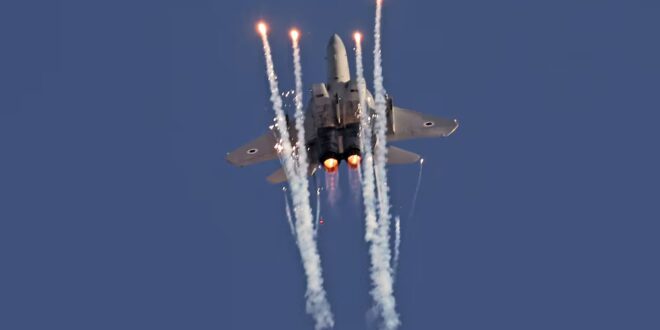Israeli retaliation against Iran after Saturday’s drone and missile attack could take many forms despite the country’s reliance on air power, analysts have told The National.
Israel has given little indication of the approach it plans to take in the days ahead. Early on Sunday, Defence Minister Yoav Gallant said “the campaign hasn’t ended”.
The range of options Israel might explore is due to political and technical constraints that could shape the operation.
On the technical side, the Israeli air force would be challenged by a major long-range attack against Iran – a complex operation involving aerial refuelling for most of the aircraft involved, and long flying hours placing strain on crews. Once over Iran, they would face dense air defence systems, while military and nuclear facilities have been built underground.
That is despite extensive planning, including a large exercise in 2022 that the Israeli air force said focused on “long-range flight, aerial refuelling and striking distant targets”.
Some available routes for hitting targets in Iran are about 2,000km one way, giving Israeli jets such as the F-15 little time to carry out missions before having to return to base, even with additional external fuel tanks.
That is not to say it is impossible – US jets struck Libya in 1986’s Operation El Dorado Canyon, flying a 10,000km round trip from the UK, more than 13 hours. But experts say it is very high risk.
On the political side, Israel will have to weigh up the risk of dragging the US into the war.
“Part of the reason the US helped Israel so much in its air defence on Sunday morning was to not give Israel an excuse to retaliate,” says Yoel Guzansky, a senior researcher at the Israeli think tank INSS.
“If some of those drones and missiles hit in a more significant manner yesterday then the urge to retaliate in Israel would be stronger, which would make it harder for the US to maintain the status quo and prevent escalation in the region.”
Israel has a fleet of ageing air-to-air refuelling tankers but modern KC-46A replacements are set for delivery in 2025.
This creates challenges. With the ability to fly for 36 hours, the KC-46A has a high endurance for long missions and comes equipped with anti-electronic jamming equipment to make the large target safer from attack.
At the same time, Israel’s stealthy F-35s, vital for penetrating enemy airspace and evading radar, can carry external fuel tanks, but these can jeopardise the stealth aspects of the aircraft, although there are claims Israel has designed stealthy fuel tanks.
The weight of external fuel tanks also limits bomb loads, which are vital if Israel wants to damage underground Iranian drone sites or nuclear facilities. Israel has a number of huge GBU-72, 2,267kg “bunker buster” bombs that it is thought would be critical for hitting Iran’s underground sites.
The long distance will influence flight paths, possibly through the airspaces of friendly and hostile countries.
That introduces unpalatable political considerations, says Raphael Cohen, a director at Project Air Force at Rand, a US think tank.
“The tanker gap is a limiting factor on the response but ultimately if Israel chooses not to respond, it will likely be more for political reasons, including keeping western and friendly Arab countries on its side, than for military capacity ones,” he says.
“There is also the question of access, basing and overflight here too, especially for manned aircraft. Some of the contours of response will be determined by which countries, if any, grant the Israelis tacit access to their airspace. I can also imagine retaliation via other means, missiles, naval forces, one-way drones and so on. The Israelis might also just double down on going after Quds Force operatives abroad too.”
That refers to follow-on attacks after the original April 1 attack on Iran’s embassy compound in Damascus that killed two Iranian generals in the Islamic Revolutionary Guards Corps, leading to Iran’s retaliation.
Unlike Iran, Israel lacks a huge arsenal of long-range missiles, although it has a number of Jericho ballistic missiles that could easily hit Iran. It is not clear exactly how many of them exist, however, because the devices are thought to be part of Israel’s nuclear deterrence, and might not be used with non-nuclear warheads.
Similarly, Israel might opt for a submarine-launched cruise missile attack against Iran, but unlike US nuclear attack submarines, which can carry 154 cruise missiles, Israel’s five Dolphin 2 submarines can only carry a few, massively limiting a counter-strike.
New era of conflict
Israel faces a major dilemma as it weighs up whether to heed US calls for calm in a region on the brink of war, against what many in the Israeli security establishment say is a desperate need to hit Iran hard.
Sima Shine, a former senior Mossad official focused on Iran, says Tehran embraced a “completely new paradigm” towards Israel on Sunday by becoming the first country to directly attack Israel since Saddam Hussein launched missiles in 1991. Iraq fired a peak average of five Scud ballistic missiles a day at Israel during the Gulf War in an attempt to expand the conflict into a regional crisis.
“Israel can use yesterday’s situation in order to start pursuing a new arrangement in the region,” she argues. “This is a very unique strategic opportunity for Israel, although I don’t know if this current government is able to take it.”
Israel continued to hit Iranian proxy forces on Sunday, including with a strike deep into Lebanese territory that the Israeli military said targeted a “significant weapons manufacturing site” belonging to Lebanese militant group Hezbollah.
 Eurasia Press & News
Eurasia Press & News



